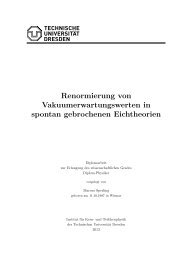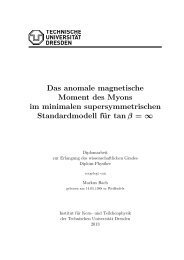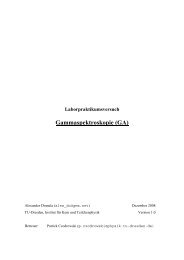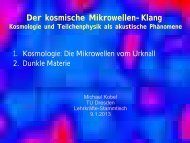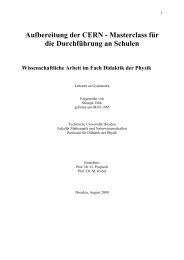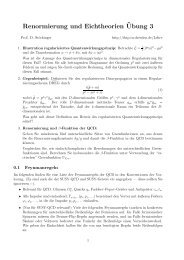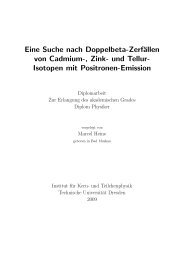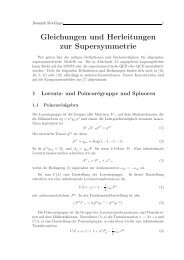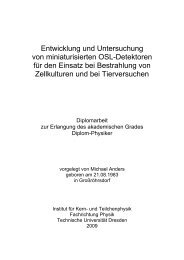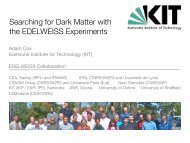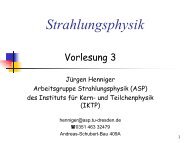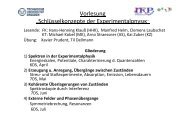a design study for a cobra upgrade to - Institut für Kern- und ...
a design study for a cobra upgrade to - Institut für Kern- und ...
a design study for a cobra upgrade to - Institut für Kern- und ...
You also want an ePaper? Increase the reach of your titles
YUMPU automatically turns print PDFs into web optimized ePapers that Google loves.
4.2 Detec<strong>to</strong>r assembly 47<br />
drops sharply at 400 nm and the reflectivity of Al also decreases (figure<br />
4.11). MgO is a suitable reflec<strong>to</strong>r also <strong>for</strong> light of lower wavelength.<br />
These external reflec<strong>to</strong>rs yield a good light collection efficiency which<br />
can be further improved by increasing the internal reflection. The material<br />
surro<strong>und</strong>ing the scintilla<strong>to</strong>r should there<strong>for</strong>e have a low refractive<br />
index. A gap of air between the scintilla<strong>to</strong>r and the refrac<strong>to</strong>r is a convenient<br />
and effective solution. With such an assembly θB reduces <strong>to</strong><br />
42 ◦ <strong>for</strong> nscint = 1.5. The surface of the scintilla<strong>to</strong>r can be polished or<br />
gro<strong>und</strong> leading <strong>to</strong> diffuse or specular internal reflection [29, 28].<br />
OPTICAL COUPLING. The coupling between the scintilla<strong>to</strong>r and the<br />
electronic readout should transmit as much light as possible. A layer<br />
of air in between should be avoided. A small air gap between a CsI:Tl<br />
crystal (nCsI:T l=1.79) and a pho<strong>to</strong>diode (nP D=1.5) reduces the electron<br />
yield by 15 % [39]. An optical glue, grease or oil with an refraction index<br />
between the scintilla<strong>to</strong>r and the PMT or diode window is the optimal<br />
optical coupling (see [39] <strong>for</strong> more details). The PMT window mostly<br />
consists of glass or quartz with an refraction index of nwindow=1.5. The<br />
refraction index of silicon matches very good with organic scintilla<strong>to</strong>rs.<br />
Finding a suitable optical grease <strong>for</strong> inorganic scintilla<strong>to</strong>r is more complicated<br />
[28, 29].<br />
LIGHT GUIDES are coupled in between the scintilla<strong>to</strong>r and the readout.<br />
They are used if the direct coupling is impossible or not desired due <strong>to</strong><br />
lack of space, an inconvenient scintilla<strong>to</strong>r shape, the presence of magnetic<br />
fields or <strong>for</strong> a reduction of the radioactive backgro<strong>und</strong> induced by<br />
the readout electronics. Pho<strong>to</strong>ns, entering the light guide reach through<br />
internal reflexion <strong>to</strong> the readout. The light guide surface is often polished<br />
and good results are obtained with external reflec<strong>to</strong>rs. R. L. Garwin<br />
declared with phase space arguments that the pho<strong>to</strong>n flux density<br />
in light guides is not compressible. Accordingly, due <strong>to</strong> the Liouville<br />
Theorem a flux of light with the intensity Iin, incident at an area Ain,<br />
cannot be compressed in<strong>to</strong> a smaller cross section area at the output<br />
Aout. Due <strong>to</strong> loss, the light intensity at the output is only in the ideal<br />
case Iin · Aout/Ain and in general smaller. [28, 29, 30]<br />
WAVE LENGTH SHIFTER (WLS) play an important role <strong>for</strong> big scintilla<strong>to</strong>r<br />
volumes. They permit the collection of scintillation light from big<br />
areas and enable the detection of the scintillation light with readout<br />
electronics of smaller area. Wave length shifters are essentially light<br />
guides with an admixture of a fluorescent wave length shifting material.<br />
They absorb incident scintillation light and reemit light with<br />
a longer wavelength. The WLS is coupled optically <strong>to</strong> the electronic<br />
readout, but is usually separated from the scintilla<strong>to</strong>r crystal by an air



